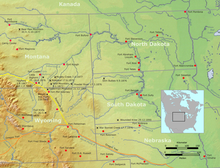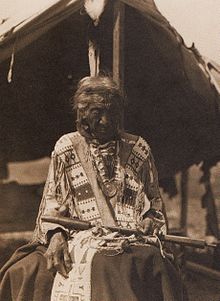Red cloud
Machpiya-luta ( Lakota : Maȟpíya Luta), better known as Red Cloud ( Red Cloud * 1. December 1822 at the fork of the Platte River in what is now Nebraska ; † 10. December 1909 at the Pine Ridge Reservation , South Dakota ) was leader of the Bad Faces (Ite Sica), a militant group of Oglala - Lakota - Indians , and one of the greatest military and political leaders of the plains Indians .
Red Cloud's mother was an Oglala-Lakota, his father a Brulé - Lakota . After his father's early death, he was raised by his uncle, Chief Smoke.
Red Cloud refused to sign the Treaty of Fort Laramie in 1868 until the army cleared the forts along the Bozeman Trail. He fought every attempt by the whites to build a railway line through the Powder River area, and was so successful that the conflict was named after him the Red Cloud War . In 1870 he came to Washington DC for the first time; from then on he worked for peace.
Childhood and youth
Red Cloud was born in the winter of 1822 in a camp in the middle of the prairie near the North Platte River in what is now Nebraska.
There are various variations about the origin of his name.
- Legend has it that Red Cloud was born the night a meteor swept across the Lakota lands, leaving a swarm of red clouds behind. Many Lakota babies are said to have received the name Red Cloud as a result.
- A second story goes that Red Cloud originally inherited his grandfather's name, Two Arrows . When, as a youth, he was commanded by a troop and ordered his men to wrap red blankets around them so that it looked like a red cloud when they attacked enemy ranks, the enemies are said to have fled in panic. Thereupon Red Cloud got his name, since he was in command.
His parents died when he was a little boy, so his older sister and uncle White Hawk took care of the orphan . White hawk taught Red Cloud the craft of the hunter and warrior. He said that if Red Cloud weren't so wild and disobedient, he would have what it takes to be a great chief .
Warrior and chief

When cholera was introduced by immigrants along the Oregon Trail to the west in 1849 , many Indians died because their immune system was powerless against such pathogens. It was then that Red Cloud became known as a shaman and healer because he was able to produce a plant extract that would give patients relief.
In the 1850s and early 1860s, the Lakota were increasingly pushed westward. This led to clashes with the Crow who were eventually displaced by the Lakota from the area east of the Bighorn Mountains. But even this last great retreat and hunting area threatened to be lost to the Lakota when gold was found in Montana in 1862 and roads were built to the gold fields. Within a year, gold diggers and traders flocked to the site along the new Bozeman Trail , which branched off from the Oregon Trail near Fort Laramie . This led to many armed conflicts, as the Lakota feared the destruction of their livelihood. Indian war troops, led by Red Cloud, attacked passing treks. Then the Bozeman Trail was only called "Bloody Bozeman" ( Bloody Bozeman ).
First negotiations
In June 1866, the US government was forced to negotiate with the Indian tribes. The chiefs concerned went to Fort Laramie, the peace negotiations were peaceful. At first it looked as if the Indians were ready to allow the trail if the wild herds of buffalo weren't chased away or shot. When Red Cloud learned that a garrison was already ready to build fort along the Bozeman Trails, the tide turned. In a recent speech, Red Cloud expressed that he would never allow forts to be built: the white father (the US president) sends us presents and wants us to sell him the street. But before the Indians say yes or no to it, the white chief (the commander of the US troops entrusted with the operation, Colonel Henry Carrington ) comes with his soldiers and steals them. Before the translator had translated Red Cloud's words, Red Cloud stormed off with other influential chiefs.
Only a few less important chiefs stayed and signed the treaty. Colonel Carrington moved north with his troops to begin building the forts.
In the months that followed, warriors from all over the Powder River gathered around Red Cloud. Soon he had gathered 4,000 warriors. With them he waged a constant, guerrilla-like war against the garrisons, treks and forts. Red Cloud was aware that the Indians would starve to death if they lost these hunting grounds.
Fetterman Skirmish
On December 21, 1866, Lakota warriors ambushed an 80-man command under Captain William Fetterman who had moved out of Fort Phil Kearny . Fetterman had pursued the Sioux further than Colonel Carrington's orders had allowed. He then fell in battle with all his men before reinforcements could be brought in from the fort. This battle was named the Battle of the Hundred Dead by the Indians ; the whites called it the Fetterman Battle .
New soldiers were hastily called up afterwards, and the battle around the Powder River area - known as the Battle of Red Cloud or the Red Clouds War - continued.
contract
All forts in the Lakota area were constantly besieged, so that their occupants were hungry and thirsty. Any white man who set foot on the Bozeman Trail also risked his life. In April 1868, the US government was once again forced to initiate a peace negotiation. However, Red Cloud sent back all negotiators with a message that he would not come until all soldiers had left the Lakota area. Without the approval of Red Cloud, the contract was worthless. The next summer, all soldiers were summoned from the Indian territory and Red Cloud's warriors burned the forts. Red Cloud took its time and did not come to Fort Laramie until December 6, 1868, to sign the contract. The contract stipulated that the area around the Powder River was from now on "unrestricted Indian territory".
Peacemaker
Red Cloud was the first Indian chief to achieve a successful outcome against the United States that was equal to a victory. However, it should be the last.
After a visit to the eastern United States, Red Cloud was so impressed by the power of the whites that he vowed never to fight them again. Red Cloud said during a speech: "Our people melt like the snow on the hillside in the warmth of the sun, while the members of your people sprout from the earth like blades of grass in spring." Many Indians turned away from him, believing that he sold himself to the white man and allowed himself to be impressed by him. He was also mocked by great chiefs, such as Sitting Bull , but Red Cloud remained staunch.
After the contract was certified, Red Cloud acted as a diplomat for his people. He was a total of eight times in Washington to the US President to talk to him about various things, he also sought a policy of reconciliation with the whites.

But Red Cloud realized that reconciliation would never happen. Other chiefs had been arguing with the officials since it was signed because they had not been made clear what the attached twelve articles said. As early as 1876, the Lakota were forced to give up the Powder River land for which they had fought so hard. The new, much smaller reserve kept shrinking as a lot of land was sold to white settlers. Red Cloud refused to participate in a planned uprising in 1876. What he had seen of the world and power of the white man strengthened his belief that armed resistance was in vain. But he was all the more committed to Indian interests in a diplomatic sense. For example, he stubbornly resisted the sale of Indian reserve land. He scrutinized the relevant agencies carefully until finally Agent McGillycuddy removed the now-old Lakota chief from his position.
By the time Red Cloud was exhausted and died half-blind in 1909, the Lakota reservation was already splintered into five smaller ones. His son, grandson and part of his family emigrated to Italy around 1930.
His grave is in the village of Pine Ridge on the Pine Ridge Reservation in South Dakota.
See also
literature
Non-fiction
- Dee Brown : Bury my heart at the bend of the river . Knaur Verlag, Munich 2005, ISBN 3-426-62804-X
- George Fronval, Frederik Hetmann (translator): The great book of the Indians . Boje Verlag, Stuttgart 1976, ISBN 3-414-10730-9 (Original title: La véritable histoire des Indiens Peaux-Rouges )
- Gilbert Legay, Nina Schindler (arr.): Atlas of the Indians of North America . Carlsen Verlag, Hamburg 1995, ISBN 3-551-13238-0
Fiction
- Ernie Hearting: Red Cloud
This article is based on the article Red Cloud ( Memento from July 1, 2010 in the Internet Archive ) from the free encyclopedia Indianer Wiki ( Memento from March 18, 2010 in the Internet Archive ) and is under Creative Commons by-sa 3.0 . A list of the authors was available in the Indian Wiki ( Memento from July 1, 2007 in the Internet Archive ).
Web links
Individual evidence
| personal data | |
|---|---|
| SURNAME | Red cloud |
| ALTERNATIVE NAMES | Machpiya-luta; Maȟpíya Lúta; Red cloud |
| BRIEF DESCRIPTION | military and political leader of the Plains Indians |
| DATE OF BIRTH | December 1, 1822 |
| PLACE OF BIRTH | at the fork of the Platte River in present-day Nebraska |
| DATE OF DEATH | December 10, 1909 |
| Place of death | Pine Ridge Reservation , South Dakota |

